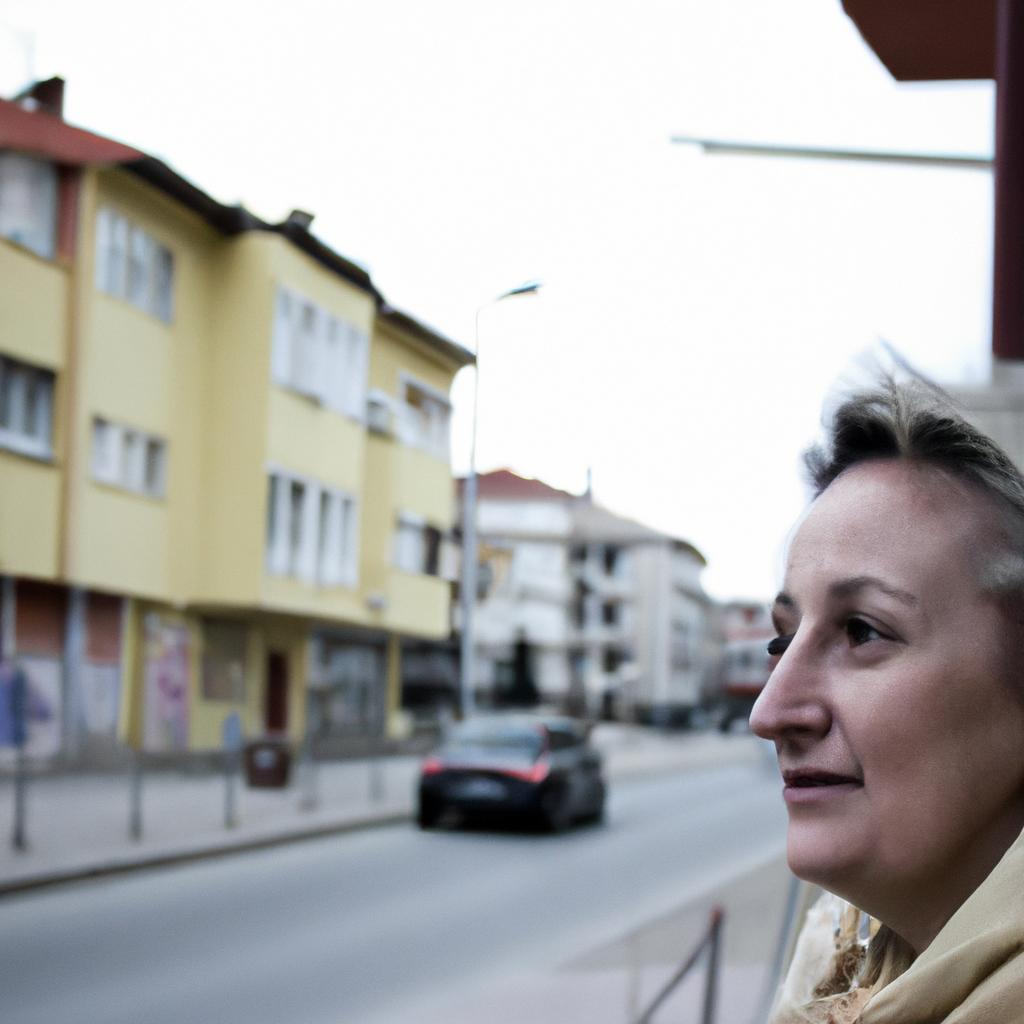Urban sociology is a branch of sociology that focuses on the study of social dynamics within urban settings. It examines how various factors such as population size, density, and diversity influence social interactions, inequalities, and patterns of behavior in cities. This field of study seeks to understand the complex interplay between individuals, communities, institutions, and their physical environment in shaping urban life.
For instance, consider the case study of Metropolis City—a bustling metropolis characterized by towering skyscrapers, diverse neighborhoods, and a vibrant street culture. In this cityscape teeming with millions of residents from different backgrounds and walks of life, urban sociologists would explore how people navigate through social networks and form relationships amidst the fast-paced urban lifestyle. They would investigate how socioeconomic disparities manifest themselves within the city’s spatial organization—examining issues such as residential segregation, access to public resources like education or healthcare facilities, and employment opportunities for different groups.
Moreover, urban sociology also delves into the impact of globalization and technological advancements on urban spaces. As cities become increasingly interconnected on a global scale through trade networks and digital communication platforms, researchers seek to comprehend how these processes shape cultural exchange, economic development, and political power dynamics within urban contexts. By employing theoretical frameworks rooted in sociological theory , urban sociologists analyze the social and cultural consequences of urbanization, modernization, and globalization. They draw on concepts such as social capital, spatial inequality, gentrification, and community development to understand how cities function and evolve.
In addition to theoretical analysis, urban sociologists also employ various research methods to collect data and generate insights. These methods include surveys, interviews, participant observation, archival research, and statistical analysis. Through these approaches, they aim to uncover patterns of social interaction, identify emerging trends in urban life, and propose policy recommendations for addressing social issues within cities.
Overall, urban sociology offers a comprehensive understanding of the complexities of urban life. By examining the intricate relationships between individuals and their environment in cities, this field sheds light on the social dynamics that shape our everyday experiences in urban settings. Whether it is studying the impact of gentrification on local communities or analyzing how public transportation systems influence social mobility, urban sociologists play a crucial role in informing policies that promote inclusivity and well-being in cities.
Urbanization and Social Change
Urbanization, the process of population shifting from rural to urban areas, has been a significant driver of social change in cities around the world. The rapid growth and development of urban areas have transformed societies in various ways, ranging from economic advancements to cultural shifts. To illustrate this point, let us examine a hypothetical case study of an agricultural village that experiences urbanization.
Initially, this village primarily relied on agriculture as its main source of livelihood. However, due to increasing industrialization and job opportunities in nearby cities, a considerable number of villagers began migrating towards these urban centers in search of better prospects. As more people left the village for the city, there was a decline in agricultural activities resulting in reduced food production and local employment opportunities.
This example highlights several key aspects associated with urbanization and social change:
- Population Growth: Urbanization often leads to substantial population growth within cities. This influx can exert pressure on existing infrastructure such as housing, transportation systems, and public services.
- Economic Transformation: Cities attract diverse industries and offer varied employment opportunities compared to rural areas. This can lead to changes in occupational patterns as individuals transition from traditional agrarian jobs to non-agricultural sectors.
- Cultural Shifts: Urban environments foster multicultural interactions due to increased diversity resulting from migration flows. Consequently, these interactions may influence cultural practices, values, norms, and even language spoken within communities.
- Social Inequality: Urbanization is also associated with rising income disparities between different socioeconomic groups. While some individuals benefit from economic prosperity brought by urbanization, others may face marginalization or exclusion due to limited access to resources and services.
To further understand these dynamics surrounding urbanization’s impact on society, it is essential to explore other facets like population density and social interactions. By examining how higher population densities affect individual behaviors and community dynamics within cities, we gain valuable insights into the intricate relationship between urbanization processes and social transformation.
Population Density and Social Interactions
Transitioning smoothly from the previous section discussing urbanization and its impact on social change, we now explore how population density plays a pivotal role in shaping social interactions within cities.
One example that illustrates the influence of population density is the bustling metropolis of New York City. With its high concentration of individuals across various neighborhoods, this city serves as an ideal case study to understand the effects of dense populations on social dynamics. In such an environment, it becomes crucial to examine how individuals navigate through crowded spaces while maintaining their sense of identity and connection with others.
-
The following bullet points highlight key aspects related to population density:
- Increased competition for resources and opportunities.
- Heightened anonymity among residents leading to reduced interpersonal relationships.
- Greater exposure to cultural diversity fostering multiculturalism but also potential conflicts.
- Enhanced chances for collaboration and innovation due to proximity between professionals.
To delve further into understanding the intricate relationship between population density and social interactions, let us consider a three-column table showcasing different experiences based on varying levels of population density:
| Low Population Density | Moderate Population Density | High Population Density |
|---|---|---|
| Spacious living areas | Semi-detached houses | Apartment complexes |
| Lower crime rates | Mixed residential-commercial zones | Dense skyscraper structures |
| Close-knit communities | Public transportation networks | Crowded public spaces |
As evident from this table, each level of population density carries distinct characteristics impacting community cohesion, safety, architectural design, and overall lifestyle choices. These factors shape people’s day-to-day lives within urban environments.
Understanding the multifaceted nature of social dynamics influenced by population density helps us recognize both advantages and challenges inherent in densely populated cities like New York City. It is crucial to acknowledge the need for policies and urban planning strategies that ensure a balance between social cohesion, individual well-being, and sustainable development.
Transitioning seamlessly into the subsequent section on “Inequality and Social Stratification,” we will explore how population density intertwines with these factors to shape urban societies even further. The quest for understanding the intricate dynamics of cities continues as we delve deeper into issues of inequality within urban spaces.
Inequality and Social Stratification
Section H2: Inequality and Social Stratification
Population density not only influences social interactions but also plays a significant role in shaping the patterns of inequality and social stratification within urban areas. To illustrate this, let us consider an example of two neighborhoods situated in the same city. Neighborhood A consists of high-rise apartments, while neighborhood B comprises single-family homes with spacious yards.
Firstly, it is important to note that population density can directly impact access to resources and opportunities. In neighborhood A, where the population is densely packed into vertical living spaces, residents often face limited access to public parks or recreational facilities due to space constraints. On the other hand, residents in neighborhood B enjoy larger yards and more green spaces, fostering a sense of community and providing ample room for outdoor activities. This disparity in resource availability based on population density can contribute to unequal outcomes between these two neighborhoods.
Secondly, higher population densities are commonly associated with greater income disparities among residents. The table below highlights key indicators related to income inequality between neighborhoods A and B:
| Indicator | Neighborhood A | Neighborhood B |
|---|---|---|
| Median Household Income | $40,000 | $70,000 |
| Poverty Rate | 20% | 5% |
| Education Attainment (Bachelor’s Degree or Higher) | 15% | 45% |
| Unemployment Rate | 10% | 3% |
As shown above, neighborhood A exhibits lower median household income levels coupled with higher poverty rates compared to neighborhood B. Additionally, educational attainment is significantly lower in neighborhood A than in neighborhood B. These discrepancies can be attributed partly to the influence of population density on economic opportunities and social mobility.
Lastly, social stratification within urban environments is closely tied to population density dynamics. In highly dense areas like neighborhood A, there tends to be a higher concentration of marginalized communities, resulting in the formation of socio-economic divisions. This segregation can perpetuate inequalities and hinder social cohesion within these neighborhoods.
The interplay between population density and social stratification underscores the need for effective urban policies that address inequality and promote inclusivity. In the subsequent section on “Urban Development and Gentrification,” we will explore how these dynamics shape the transformation of cities over time, shedding light on the challenges faced by various communities amid rapid urbanization.
Urban Development and Gentrification
In the previous section, we explored the dynamics of inequality and social stratification in urban settings. Now, let us turn our attention to another significant aspect of urban sociology: urban development and gentrification. To illustrate this concept, imagine a once rundown neighborhood that is now experiencing an influx of young professionals seeking affordable housing close to the city center.
Urban development refers to the physical transformation of cities over time, including changes in infrastructure, land use patterns, and architectural styles. One example of successful urban development can be seen in the revitalization efforts undertaken in the Brooklyn neighborhood of Williamsburg, New York City. In recent years, this area has experienced a surge in new businesses, trendy restaurants, and upscale apartments as it attracts affluent residents who appreciate its unique character.
However, along with urban development often comes gentrification – a complex process with both positive and negative consequences. Gentrification occurs when wealthier individuals move into lower-income areas, leading to rising property values and displacement of long-time residents. This phenomenon raises important questions about social justice and equity within cities.
- Displacement of low-income families from their homes
- Loss of community cohesion due to changing demographics
- Increased cost of living for longtime residents
- Unequal access to amenities such as quality education or healthcare facilities
An illustrative three-column table further highlights some key features associated with gentrification:
| Positive Aspects | Negative Aspects | Controversies |
|---|---|---|
| Economic growth | Displacement | Cultural loss |
| Improved aesthetics | Rising rent prices | Resistance from local communities |
| Enhanced safety measures | Decreased affordability | Speculation-driven investment |
As we navigate through discussions on urban sociology, it becomes clear that gentrification represents a multifaceted issue that requires careful consideration. Understanding the positive and negative consequences, controversies, and emotional impact on individuals and communities is crucial for developing effective policies that promote inclusive urban development.
Transitioning into our next section on “Urban Crime and Deviance,” we will delve into the complex relationship between cities and criminal behavior, shedding light on how social dynamics contribute to patterns of crime within urban environments.
Urban Crime and Deviance
Urban areas are not immune to issues of crime and deviant behavior. In fact, the dynamics of cities often create an environment that is conducive to such activities. This section will explore the various factors contributing to urban crime and deviance, including social disorganization, poverty, inequality, and lack of community cohesion.
To illustrate this point, let’s consider a hypothetical case study in a bustling metropolis. In a neighborhood characterized by high levels of unemployment and limited access to resources, individuals may resort to criminal activities as a means of survival or out of frustration with their circumstances. The lack of opportunities for upward mobility can lead some residents to engage in illegal behaviors as they perceive it as their only option.
One key factor influencing urban crime rates is social disorganization. When communities face economic decline or rapid population changes, social bonds weaken, resulting in decreased informal control mechanisms. As a result, criminal elements may fill the void left by weakened community structures. Additionally, poverty plays a significant role in shaping crime patterns within urban environments. Individuals living below the poverty line may experience heightened desperation, leading them to engage in unlawful acts as a means to meet basic needs.
The pervasive presence of inequality also contributes significantly to urban crime and deviance. Communities marked by stark disparities between socioeconomic classes often breed resentment and feelings of injustice among marginalized groups. These sentiments can fuel anti-social behaviors driven by anger or disillusionment towards society at large.
Let us now examine these contributing factors through the following bullet points:
- Social disorganization weakens community bonds.
- Poverty creates desperation and drives criminal activity.
- Inequality fosters resentment and animosity within communities.
- Lack of community cohesion hinders collective efforts against crime.
In summary, urban areas present unique challenges when it comes to maintaining safety and order due to various underlying factors. Social disorganization, poverty, inequality, and lack of community cohesion all contribute significantly to higher rates of crime and deviance within cities. Understanding these dynamics is crucial for policymakers, urban planners, and sociologists as they seek to address these issues effectively.
Transitioning into the subsequent section on “Community and Social Networks,” it becomes evident that strengthening community bonds and fostering social networks are essential in combating urban crime and deviance. By promoting a sense of belonging and providing individuals with opportunities for positive engagement, communities can work together towards building safer urban environments.
Community and Social Networks
Transitioning from the previous section, where we explored the intricacies of urban crime and deviance, we now delve into an equally crucial aspect of urban sociology – community and social networks. To illustrate this topic further, let us consider a hypothetical case study:
Imagine a bustling metropolis with diverse neighborhoods; one such neighborhood is known for its strong sense of community cohesion. Residents actively engage in various communal activities like organizing regular block parties, establishing neighborhood watch programs, and supporting local businesses. This vibrant network not only fosters collective identity but also enhances social capital within the area.
Within cities’ complex social fabric, communities play a pivotal role in shaping individuals’ experiences as well as influencing broader societal dynamics. Let us explore some key factors that contribute to the formation and functioning of these vital networks:
-
Geographic Proximity:
- Physical proximity facilitates face-to-face interactions
- Increased opportunities for spontaneous encounters
-
Shared Interests:
- Common interests create bonds among residents
- Engaging in shared hobbies or causes strengthens connections
-
Mutual Support:
- Offering assistance during personal crises or emergencies
- Providing emotional support through challenging times
-
Access to Resources:
- Sharing knowledge about local services and amenities
- Pooling resources for community-wide initiatives
To grasp the significance of community networks even more vividly, consider the following table showcasing a comparison between two distinct neighborhoods:
| Neighborhood A | Neighborhood B | |
|---|---|---|
| Community Activities | Monthly potluck dinners | Annual street fair |
| Civic Engagement | Active participation in local government meetings | Utilization of online platforms for collective decision-making |
| Trust Levels | High levels of trust and cooperation among residents | Low levels of social cohesion, resulting in decreased collaboration |
| Perceived Safety | Residents feel secure due to strong neighborhood watch programs | Concerns regarding safety due to limited community involvement |
As we conclude this section on community and social networks, it becomes evident that these intricate webs of relationships shape the dynamics within cities. They contribute to a sense of belonging, foster support systems, and enable collective action towards common goals. Understanding the factors influencing their formation and functioning is indispensable for comprehending urban sociology holistically.
By examining case studies like our hypothetical scenario and recognizing the significance through tables such as the one presented above, we gain deeper insights into how communities influence individual experiences and overall societal structures. As researchers continue to explore this multifaceted field, it is imperative to acknowledge the critical role played by community networks in shaping urban life.




